User Area
Software Release History - Version 22
Version
22.0
New Facilities and Improvements
in LUSAS Version 22.0
V22.0-1 was made available for download on 18 July 2025
This is a
maintenance release.
V22.0-0 was made available for general download on
28 May 2025
This is a major
release of new facilitites, enhancements and change requests
In summary...
In detail...
This release provides the following:
A
64-bit version of LUSAS Modeller is now available, allowing for larger
models to be created and solved in comparison to the 32-bit version.
Note that both 64-bit and 32-bit versions of LUSAS are installed by
default.
-
New
models are created in the 64-bit version of LUSAS Modeller using
the 64-bit geometry engine (as reported at the bottom of the user
interface.)
-
Opening
an existing 32-bit LUSAS model in the 64-bit version will restart
Modeller and use the 32-bit version of Modeller that uses the
32-bit geometry engine (as reported at the bottom of the user
interface.)
-
It
is possible to attempt to load a 32-bit model into the 64-bit
version of LUSAS Modeller by using the File > Import menu item,
but note that this option is intended primarily for use only by
those with a model that has become too large for a 32-bit version.
Most users should continue opening their existing 32-bit models as
described above.
-
If,
for some reason, new models are required to be created in the
32-bit version (perhaps to run user-defined scripts successfully),
a setting on the Modeller Settings page of the Configuration
Utility will allow this to take place, but the 64-bit version
should now be the preferred version of LUSAS Modeller due to the
increased size of model it can support.
Bill
of materials / Embodied carbon calculator
-
The
initial release of the Bill of Materials utility
provides a summary of the materials, sections and quantities
(length, area, volume, mass) for a selected loadcase within an
analysis.
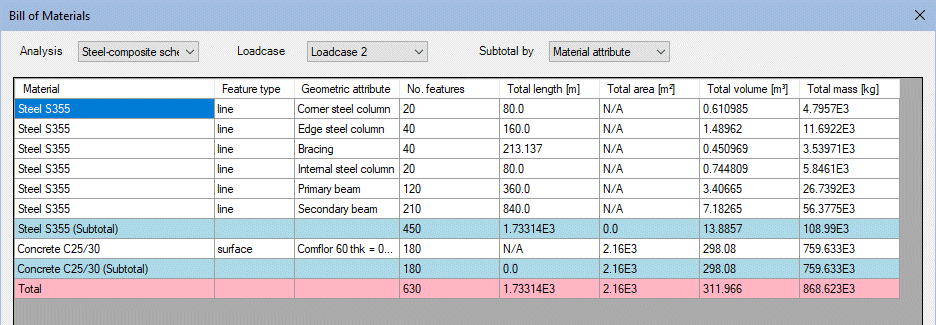

-
A new worked example
'Embodied Carbon
Calculator'
is available from the User Area of the LUSAS website. This shows how to extract a bill of material and how to quantify the embodied carbon of two conceptual structural schemes for a multi-storey building, namely a reinforced concrete (RC) frame and steel-composite frame.
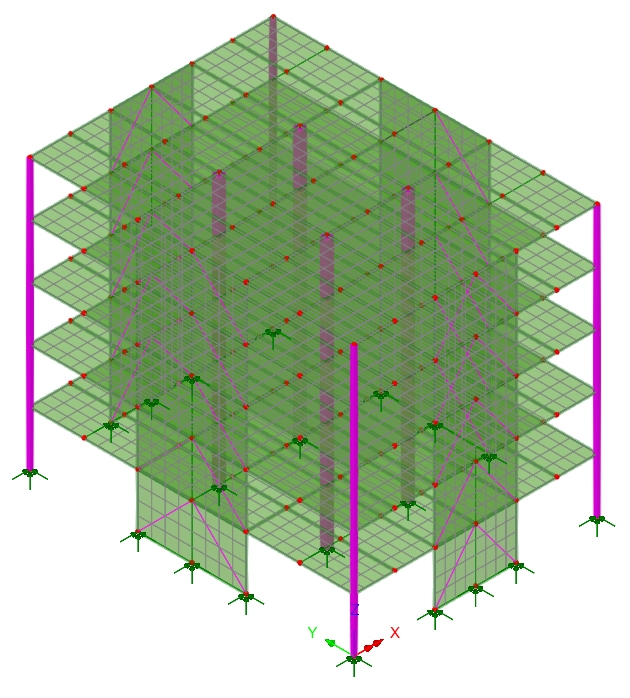 |
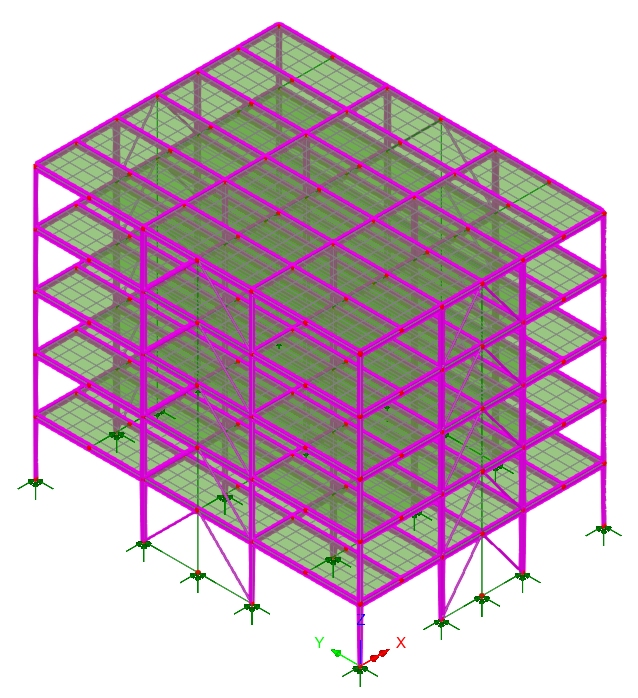 |
| RC
frame |
Steel
frame |
Vehicle
load optimisation
AASHTO
LRFD
UK CS454 Appendix C now supported
Automatic identification of influence
assignments for alternative load patterns
-
The
ability to determine which Direct Method Influence (DMI) assignments
should be considered with an "alternative load pattern"
which is already provided for VLO Envelope Runs has
been extended to VLO Runs. There
is now no need to identify which DMI assignments should be considered
with an "alternative load pattern" as for example in the
case of AASHTO, when loading at 90% with two trucks either side of the
pier for hogging regions - as opposed to one design truck in sagging
regions. In the case of AASHTO LFD Standard Specifications clause
3.11.3, AASHTO LRFD clause 3.6.1.3.1, and Korean lane loads on
continuous spans only) these alternative load patterns are now
identified automatically.
Viscous
support loading
A
new nodal viscous support load type allows you to apply viscous
support loading instead of face loading at the base of the model when
performing a seismic analysis using the 'Bicanic boundaries method'
(BBM). This has removed the requirement to manually calculate the
viscous damping coefficients when applying the seismic loading.

-
Defining
tendon properties with losses based upon time inputs and
calculated stresses is now supported for design code AS5100.5-2017.
-
The Prestress
Analysis Options dialog has been improved to
permit primary and secondary tendon losses to be considered for
'Duct friction', 'Anchorage set', 'Elastic shortening', 'Creep of
concrete',' Shrinkage of concrete', and 'Relaxation of tendons'.
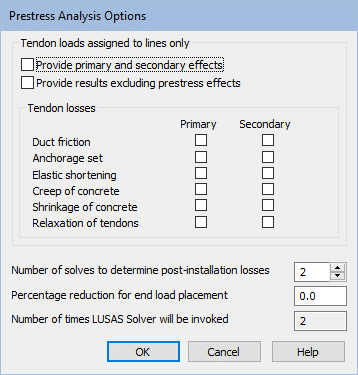
User-defined
internal points for beams
-
The
number of internal points that are used to calculate force,
moment, and displacement results along a beam can now be changed,
either to increase them to obtain a finer force/moment diagram, or
to reduce them for faster processing.
 Analysis
branch types extended Analysis
branch types extended
The
following specialised analyses can now be included in an analysis
branch, and when done will inherit their attribute assignments from
the parent loadcase, instead of inheriting them from a base analysis,
as is the case when they are defined outside of an analysis branch.
-
Direct
Method Influence Analysis
-
Pedestrian
Moving Load Analysis
-
Moving
Load Analysis
-
Vehicle
Load Optimisation
-
VLO
Envelope Run
-
Rail
Load Optimisation
-
RLO
Envelope Run
Analysis
branches allow the creation and solution of one or more
sub-analyses to investigate the response of the model at a
particular loadcase or "stage". Any number of
sub-analyses may be defined for a single parent loadcase.
Permanent
loading now supported in moving load analysis loadcases
It
is now possible to apply a permanent load to all Modeller-generated
loadcases in a Moving Load Analysis or
a Pedestrian Moving Load Analysis. This is done
initially during assignment of the load to the analysis in question.
-
For
both cases, the permanent loading is modelled as a statically applied
load and if the loadcases are re-generated (as a result of user
changes to the moving load definitions) the permanent load is
re-applied to those re-generated loadcases.
-
For
a moving load analysis the first loadcase in the set can be assigned a
material or any other attribute relevant to the analysis.
-
For
a pedestrian moving load analysis an "initial conditions, static
loadcase" is provided to allow any materials or other attributes
specific to the analysis to be assigned, and from which the initial
conditions of the dynamic analysis will be derived.
|
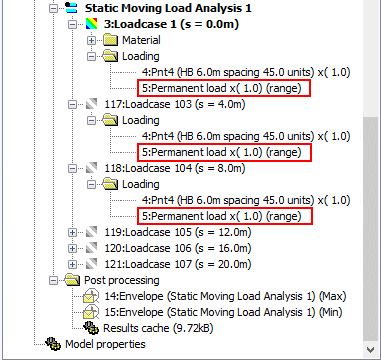
|
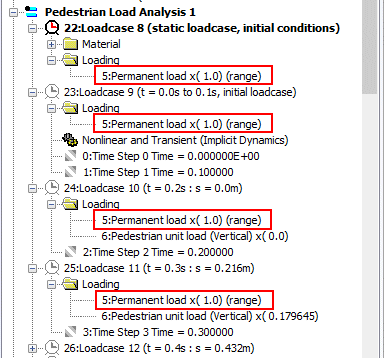
|
Nonlinear
control type now reported in the Analyses treeview
When
carrying out a nonlinear analysis the type of nonlinear and
transient control that is defined for each loadcase is now
reported within the Analyses treeview.
An
automated description is appended to the end of the existing  'Nonlinear
and Transient' entry: 'Nonlinear
and Transient' entry:
-
For
manual incrementation, the description '(Manual)' is
added.
-
For
automatic incrementation the description '(Automatic)' is
added.
-
For
time domain controls, the time domain type is added. e.g.
'(Two phase), '(Viscous)', '(Implicit dynamics)',
'(Explicit dynamics)', '(Thermal)').
Easier
identification of loading brought forward
-
A
new item ' Loading
brought forward' will be present in the 'Loading' folder
within each loadcase / stage in the Analysis treeview for
each analysis that contains a Nonlinear and Transient
control. Loading
brought forward' will be present in the 'Loading' folder
within each loadcase / stage in the Analysis treeview for
each analysis that contains a Nonlinear and Transient
control.
-
Note that it will not be present in the first nonlinear loadcase / stage (since there is no previous load that can continue); or in transient analyses, eigenvalue analyses, linear static analyses, analyses with load curves, or Fourier analyses.
|
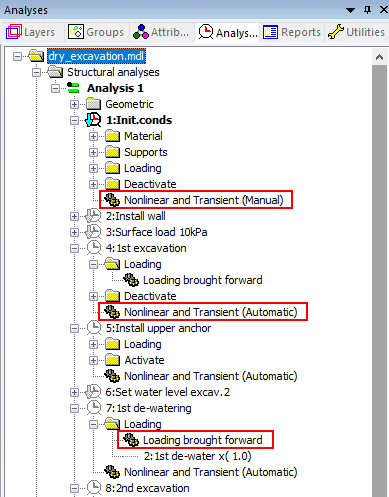
|
-
Clicking on the 'Loading brought forward' item displays a dialog that reports, by listing on separate tabs, the loading that LUSAS Solver continues (or not) from a previous loadcase / stage into the loadcase / stage being inspected. In each case, a reason is given as to why that particular load assignment does, or does not continue into the loadcase / stage of interest.

-
For
the Geotechnical option a
new results entity named 'Two-phase results' has been added to the
Contours, Values, Vectors, PRW and Graph Wizard dialogs to allow
for post-processing of geotechnical two-phase results for 2D and
3D continuum elements. Results components of Saturation, Suction,
Excess pore water pressure, Hydraulic head, Flow qX, Flow qY and
Flow qZ (3D only) are now available.
-
A
resultant flow vector component 'Flow qRSLT' has been included in
the Vectors dialog for the Two-phase results Entity.
-
Transformations
of the flow vector components Flow qX, Flow qY and Flow qZ are
also permitted. This enables visualisation of these result
components using a local coordinate system via the existing
Results Transformation dialog. When transforming results, the flow
vector component names are changed as required, for example, 'Flow
qX' becomes 'Flow qx' etc.
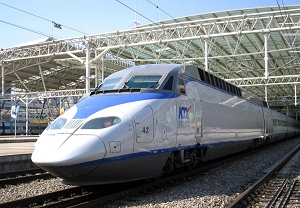 Rail
track analysis Rail
track analysis
-
The Rail
Track Analysis software option no longer
requires the use of MS Excel to read and write data from and to
spreadsheet files, or to calculate results. Instead, an
independent library is now used. As a result a significant
reduction in the time taken by reading and writing operations has
been achieved, with results processing estimated to take only
10-20% of the previously required time.
-
Copying
and pasting of data during results processing is now possible.
-
Category
charts produced during post-processing are now created as more
convenient XY scatter charts.
-
A
default colour palette with selected colours has now been
introduced, so that all the charts produced by the post-processing
tool will appear the same in all applications.
New
Modeller startup dialog and updated 'File open' and 'File save'
dialogs
-
The
new Modeller Startup dialog allows
you to create or open an existing model more easily, with preview
bitmaps provided for recently saved models.
-
An
updated File Explorer dialog allows for easier navigation to your
files.
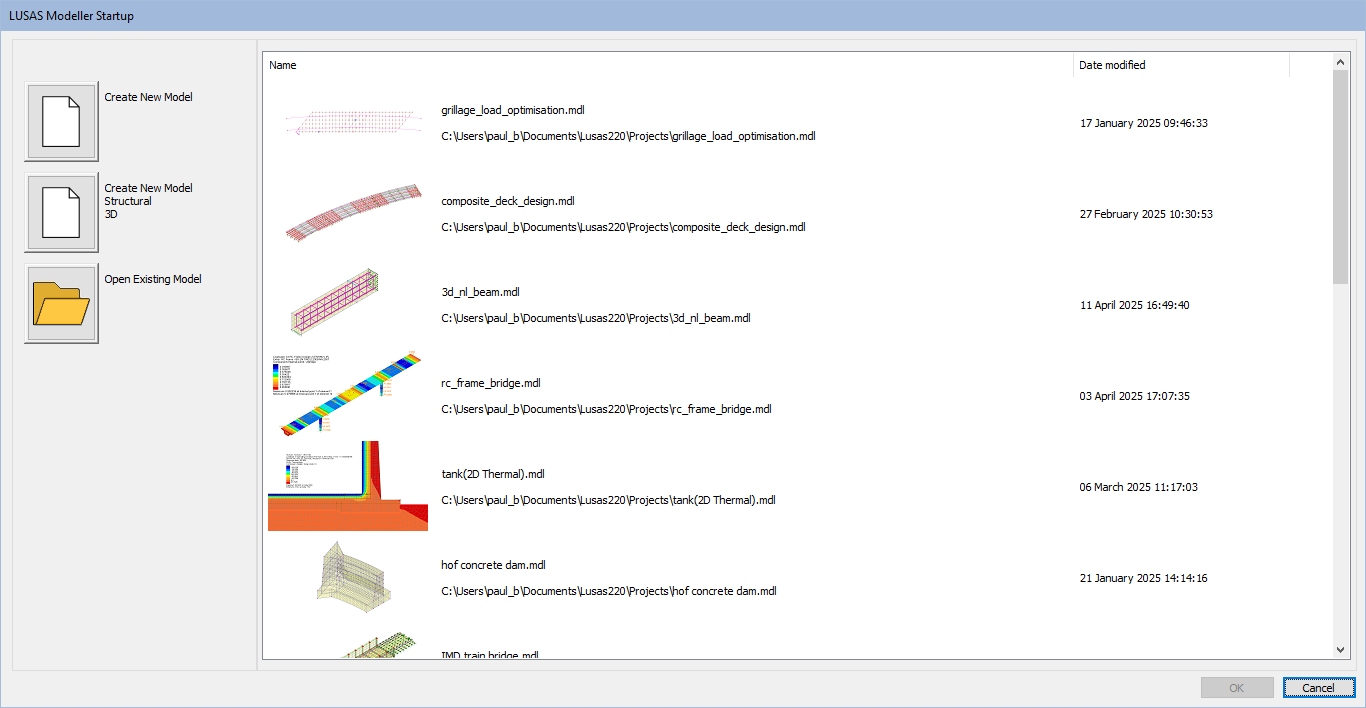
Prior
results-based variations
A
number of improvements have been made to the LUSAS
Tank software product:
-
When
creating 3D shell models of
concrete tanks, a new option 'Vertical prestress type' has been
added to the dialog, which sets the wall vertical prestress
modelling type as 'Tendon Loads' or 'Global Distributed Loads'.
Using 'Global Distributed Loads' may be easier to work with in
early design stages however it assumes that the tendons are
positioned at an eccentricity of half the wall top thickness from
the inner face, thus not following the wall centre for varying
cases. The modelling approach can later be changed to 'Tendon
Loads' through the 'Add/Update Rebars and Tendons' dialog.
-
Temporary
rectangular wall openings can now be included as part of defining
the construction stages for storage tanks modelled using 3D shell
elements in the LUSAS
Tank software product. Single, two
identical, or two non-identical openings are supported in concrete or metallic tanks.
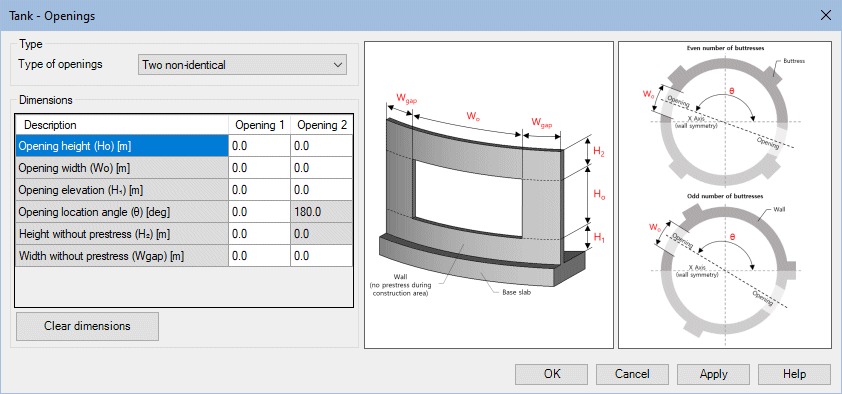
-
For
concrete tanks, in order to capture the effects due to
differential settlement of the ground or piles while the base slab
is cast, the modelled slab parts are now allowed to deform due to
self weight independently on each stage; and are then connected
through equivalent joint elements.
-
For
concrete tanks, vertical deformation in the wall during casting is
eliminated by assigning deformation reset attributes at the end of
each stage, ensuring that the as-drawn concrete pour levels are
used from the base to the roof connection.
-
Insulation
dead loads that vary during construction can now be modelled..
-
For metallic
tank roofs the angle from the centre of the roof
to the start of the Upper Compression Ring is now automatically
calculated in based on Wall, Roof Dome and Compression ring
dimensions. This roof segment is assumed to be circular (arc) and
its length is also calculated and shown.
 Script
compatibility Script
compatibility
-
The
implementation of a new geometry engine in LUSAS version 22 may
prevent some pre-version 22 LVB scripts from running successfully
in this release. Scripts created from models in previous versions
by using the File > Export facility should generally run
successfully. However, scripts created in previous versions by
recording menu / dialog interaction are unlikely to run
successfully in 64-bit LUSAS Modeller and may need to be run in
32-bit LUSAS Modeller instead.
-
Displaying,
zooming and rotating of models is faster.
-
Models
with tapering sections now load quicker.
-
Creation
of loadcase/mesh results, and gauss point and nodal results when
using the Print Results Wizard is faster.
-
Deletion
of soil-structural interface material assignments from an
eigenvalues analysis is faster.
-
Selection
of volumes within a model containing cylindrical volumes is
faster.
-
Creation
of a fleshed model view is now faster for small models.
-
Calls
made to the LUSAS Programmable Interface are now faster for
external python code.
-
Results processing
for Rail Track Analysis is significantly faster.
Rhino/Grasshopper
plugin (external application)
-
 The
initial release and subsequent update of the LUSAS-authored plugin for Rhino/Grasshopper was
announced prior to the release of LUSAS version 22. Available from
the 'food4rhino' website the plugin allows users to create a
structural model with LUSAS-compatible attributes and assignments
in Grasshopper and then create a LUSAS model directly (if LUSAS is
installed), or to create an LVB script for reading into LUSAS by
others or if a LUSAS licence is not immediately available. The
plugin is for use with Rhino version 8.08 and above. The
initial release and subsequent update of the LUSAS-authored plugin for Rhino/Grasshopper was
announced prior to the release of LUSAS version 22. Available from
the 'food4rhino' website the plugin allows users to create a
structural model with LUSAS-compatible attributes and assignments
in Grasshopper and then create a LUSAS model directly (if LUSAS is
installed), or to create an LVB script for reading into LUSAS by
others or if a LUSAS licence is not immediately available. The
plugin is for use with Rhino version 8.08 and above.
See LUSAS
plugin for Grasshopper on the 'food4rhino'
website for more information
Tekla
export to LUSAS (external application)
-
 The
LUSAS-authored 'Export to LUSAS' plugin for Tekla, available from the Tekla
Warehouse, lets you seamlessly transition from an analytical model
in Tekla to a LUSAS model. Tekla "analytical elements"
are converted to appropriate LUSAS features and finite elements,
along with cross-sections and material attributes, and the
conversion of loads and supports. The
LUSAS-authored 'Export to LUSAS' plugin for Tekla, available from the Tekla
Warehouse, lets you seamlessly transition from an analytical model
in Tekla to a LUSAS model. Tekla "analytical elements"
are converted to appropriate LUSAS features and finite elements,
along with cross-sections and material attributes, and the
conversion of loads and supports.
See Tekla
export to LUSAS for more information .
Documentation
User
manuals
Worked
Examples
Worked
examples (in PDF format) and associated files referenced by those
examples are available for download from the User Area of the LUSAS
website. New for this release are:
-
Embodied Carbon Calculator
-
Heat
of Hydration Modelling of a Concrete Slab
-
3D Nonlinear Analysis of a Concrete Beam
|